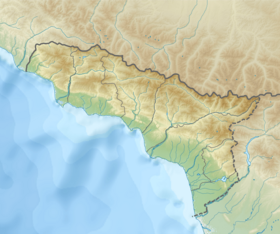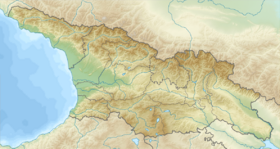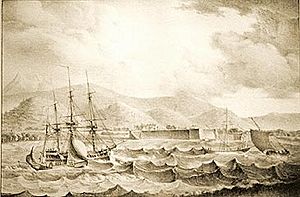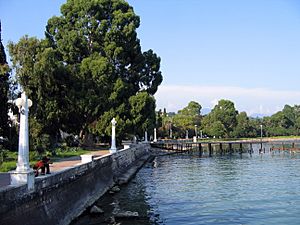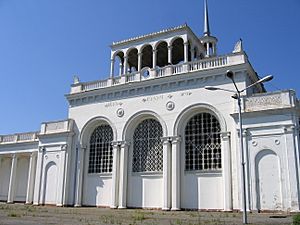Sukhumi facts for kids
Quick facts for kids
Sukhumi
Sokhumi, Sukhum, Aqwa
|
||
|---|---|---|
|
City
|
||
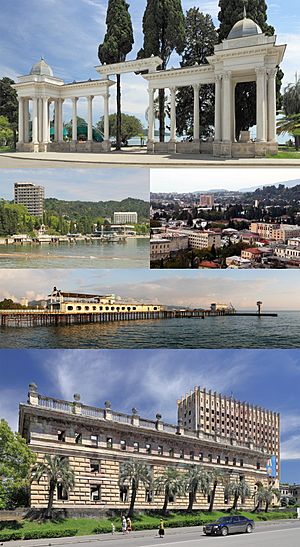
Colonnade, Embankment, Panoramic, Beach panorama, former building of the Council of Ministers
|
||
|
||
| Country (de jure) | ||
| Country (de facto) | ||
| Settled | 6th century BC | |
| City status | 1848 | |
| Area | ||
| • Total | 372 km2 (144 sq mi) | |
| Highest elevation | 140 m (460 ft) | |
| Lowest elevation | 5 m (16 ft) | |
| Population
(2018)
|
||
| • Total | 65,439 | |
| • Density | 175.91/km2 (455.6/sq mi) | |
| Time zone | UTC+3 (MSK) | |
| Postal code |
384900
|
|
| Area code | +7 840 22x-xx-xx +995 442 xx-xx-xx |
|
| Vehicle registration | ABH | |
Sukhumi is a city located on the eastern coast of the Black Sea. It is the capital and largest city of Abkhazia. Abkhazia is a state that is only partly recognized by other countries. Most countries still consider it a part of Georgia. Abkhazia has controlled the city since the Abkhazian war in 1992–93.
Sukhumi is an important port and a major rail hub. It is also a popular holiday spot. People visit for its beaches, health resorts, mineral-water spas, and warm climate. The city has an airport. It is also a member of the International Black Sea Club.
The city's history goes back to the 6th century BC. At that time, Greeks settled here and called it Dioscurias. Later, it was known as Tskhumi when it was part of the Kingdom of Abkhazia and then the Kingdom of Georgia. In the 1570s, it became part of the Ottoman Empire. The Russian Empire took control in 1810.
After the Russian Civil War, Sukhumi was briefly part of the Democratic Republic of Georgia. Then, the Bolsheviks took it over. During the Soviet Union era, Sukhumi was the capital of the Socialist Soviet Republic of Abkhazia. It later became the capital of the Abkhazian Autonomous Soviet Socialist Republic within the Georgian SSR. It was a very popular place for holidays. When the Soviet Union broke apart in the early 1990s, the city was badly damaged during the Abkhaz–Georgian conflict. Today, its population of about 60,000 is only half of what it was before the Soviet Union ended.
Contents
City Names
The city has different names in different languages. In Georgian, it is called Sokhumi (სოხუმი). Some people in the Samurzakano region call it Aqujikha (აყუჯიხა) in Megrelian. In Russian, it is called Сухум (Sukhum) or Сухуми (Sukhumi).
The name Sokhumi comes from the Georgian word Tskhomi/Tskhumi (ცხომი/ცხუმი). This word might come from the Svan word tskhum (ცხუმ), which means "hornbeam tree."
In Abkhaz, the city is known as Aqwa (Аҟәа). This name might come from a-qwara (а-ҟәара), meaning "stony seashore." Some Abkhaz traditions say Aqwa (Аҟәа) means water.
During the Middle Ages, Georgian writings called the town Tskhumi (ცხუმი). Later, when the Ottoman Empire controlled it, the Turks called it Suhum-Kale. Kale means "fortress." The first part of the name, "Suhum," is likely from the older Georgian name.
In English, the most common name today is Sukhumi. However, Sokhumi is also used more often now by groups like the United Nations and in maps like Google Maps.
City History
The city's story began around the mid-6th century BC. Before that, local Colchian tribes lived in the area. Then, Greek settlers from Miletus built a colony called Dioscurias (Greek: Διοσκουριάς). Some stories say the city was named after the twins Castor and Pollux from classical mythology. Other stories say it was founded by charioteers of the Dioscuri.
Dioscurias became a busy trading center. It traded with Greece and local tribes. The city imported salt and goods from Greece. It exported local timber, linen, and hemp. It was also a big center for the slave trade in Colchis. Many different languages were spoken in its markets.
Even though the sea covered some parts of Dioscurias, it continued to do well. It became an important city for Mithridates VI of Pontus in the 2nd century BC. The city even made its own bronze coins. Under the Roman emperor Augustus, the city was renamed Sebastopolis (Greek: Σεβαστούπολις). But it was not as rich as before. In the 1st century, Pliny the Elder said it was almost empty. However, it still existed in the 130s. Parts of Roman towers and walls have been found underwater.
In 542, the Romans left the town and destroyed its fort. They did this to stop the Sasanian Empire from taking it. But in 565, Emperor Justinian I rebuilt the fort. Sebastopolis remained a Byzantine stronghold until it was attacked by the Arabs in 736.
Medieval Times
After the Arab attacks, the town became known as Tskhumi. The kings of Abkhazia rebuilt it. It became very successful during the Georgian Golden Age in the 12th–13th centuries. Tskhumi was a major trading hub with European sea powers, especially with the Republic of Genoa. The Genoese set up a trading port here in the late 13th century. They even had a Catholic bishopric.
Tskhumi became the summer home for the Georgian kings. It was an important cultural and administrative center. Later, Tskhumi was the capital for the Mingrelian rulers. Vameq I Dadiani, a powerful ruler, even made his coins in this city.
In 1451, the Ottoman Empire navy took the town for a short time. Later, the princes of Abkhazia and Mingrelia fought over Tskhumi. Finally, the Turks took control in the 1570s. They built strong defenses and called it Sohumkale. Kale means "fort." The first part of the name might come from the earlier Georgian name.
Modern History
In 1810, at the request of a pro-Russian Abkhazian prince, Russian Marines attacked the town. It became an important Russian outpost in the North West Caucasus. Sukhumi was made a seaport in 1847. It was directly taken over by the Russian Empire in 1864. During the Russo-Turkish War of 1877–1878, Ottoman forces briefly controlled the town. After being taken by Russia, Sukhumi became the main city of the Sukhumi Okrug.
After the Russian Revolution of 1917, Sukhumi was caught in the chaos of the Russian Civil War. A short-lived Bolshevik government was stopped in May 1918. Sukhumi then became part of the Democratic Republic of Georgia. The Red Army took the city from Georgian forces in March 1921. They then declared Soviet rule.
Sukhumi was the capital of the Socialist Soviet Republic of Abkhazia from 1921 to 1931. This republic was connected to the Georgian SSR. In 1931, it became the capital of the Abkhazian Autonomous Soviet Socialist Republic within the Georgian SSR. By 1989, Sukhumi had 120,000 people. It was one of the richest cities in Georgia. Many Soviet leaders had holiday homes there.

Starting with the riots in 1989, Sukhumi was a center of the Abkhaz–Georgian conflict. The city was badly damaged during the 1992–1993 War. During the war, the city faced almost daily air strikes and artillery attacks. Many civilians were hurt. In September 1993, the battle for Sukhumi ended with many Georgians being forced to leave their homes. This included members of the pro-Georgian Abkhazian government.
The city has been mostly peaceful and partly rebuilt since then. However, it still feels the effects of the war. It has not gotten back its old mix of different ethnic groups. In 2017, its population was 65,716. This is much less than the 120,000 people who lived there in 1989. During summer holidays, the population often doubles or triples with many tourists visiting.
In 2021, there was some unrest in the city. This led to the resignation of President Aslan Bzhani.
Population
Demographics
Sukhumi's population has changed a lot over time. In 1989, before the conflict, there were about 119,150 people living in the city. A large part of the population was Georgian (41.5%) and Russian (21.6%). Abkhaz people made up 12.5%. After the 1992-1993 war, the population dropped sharply. By 2003, it was only 43,716. The number of Abkhaz people increased to 56.3%, while the Georgian population dropped to 4.0%. In 2011, the total population was 62,914. Abkhaz people made up 67.3% of the population.
Religion
Most people in Sukhumi belong to the Orthodox and Armenian Apostolic Churches. There are also people who follow Islam and the Abkhaz traditional religion.
Culture
Main Sights
Sukhumi has theaters that show classical and modern plays. The theater season runs from September to June. There are also several art galleries and museums. They show modern and historical Abkhaz art. The Sukhumi Botanical Garden was started in 1840. It is one of the oldest botanical gardens in the Caucasus region.
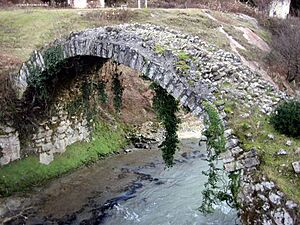
The city has many historical monuments. One is the Besleti Bridge, built in the 12th century during the time of Queen Tamar of Georgia. You can also see parts of old Roman walls and the medieval Castle of Bagrat. There are also towers from the Kelasuri Wall, also called the Great Abkhazian Wall. This wall was built between 1628 and 1653 to protect the area.
Other historical sites include a 14th-century Genoese fort and an 18th-century Ottoman fortress. The 11th-century Kamani Monastery is about 12 kilometres (7 miles) from Sukhumi. It is believed to be built over the tomb of Saint John Chrysostom. About 22 km (14 mi) from Sukhumi is New Athos. Here you can find the ruins of the medieval city of Anacopia. The New Athos Monastery was built here in the 1880s by order of Tsar Alexander III of Russia.
North of the city, in the mountains, is the Krubera Cave. It is one of the deepest caves in the world, going down 2,140 meters.
Education
Sukhumi is home to several places for learning and research. These include the Abkhazian State University and the Sukhumi Open Institute. There are also about six colleges for vocational education. From 1945 to 1954, a laboratory in the city was involved in the Soviet program to create nuclear weapons. The Abkhaz State Archive is also located here.
Before the 19th century, young people in Abkhazia mostly went to religious schools. A few children from rich families could study in other countries.
The first modern schools and colleges were built in the late 19th and early 20th centuries. They grew quickly. For example, the number of college students went from a few dozen in the 1920s to thousands in the 1980s.
Today, Abkhazia has about 12 vocational colleges. Most of them are in Sukhumi. These colleges teach young people (aged 16 to 29) about 20 different skills. Between 1200 and 1500 young people attend these colleges each year. Some of the largest colleges are:
- Abkhaz Multiindustrial College (started in 1959)
- Sukhumi State College (started in 1904)
- Sukhumi Art College (started in 1934), which has a collection of local paintings and sculptures.
- Sukhum Medical College (started in 1931)
The main university in Sukhumi is Abkhazian State University. It has its own campus with 42 departments and 8 faculties. About 3300 students attend the university each year.
Climate
Sukhumi has a humid subtropical climate. This means it has warm, humid summers and mild winters. It gets a good amount of rain throughout the year.
| Climate data for Sukhumi | |||||||||||||
|---|---|---|---|---|---|---|---|---|---|---|---|---|---|
| Month | Jan | Feb | Mar | Apr | May | Jun | Jul | Aug | Sep | Oct | Nov | Dec | Year |
| Mean daily maximum °C (°F) | 10.0 (50.0) |
10.7 (51.3) |
12.8 (55.0) |
16.8 (62.2) |
20.4 (68.7) |
24.2 (75.6) |
26.5 (79.7) |
26.8 (80.2) |
24.1 (75.4) |
20.3 (68.5) |
15.6 (60.1) |
12.0 (53.6) |
18.3 (65.0) |
| Mean daily minimum °C (°F) | 2.2 (36.0) |
2.7 (36.9) |
4.5 (40.1) |
8.3 (46.9) |
12.2 (54.0) |
16.2 (61.2) |
19.0 (66.2) |
18.6 (65.5) |
14.8 (58.6) |
10.4 (50.7) |
6.6 (43.9) |
3.9 (39.0) |
10.0 (49.9) |
| Average precipitation mm (inches) | 102 (4.0) |
76 (3.0) |
102 (4.0) |
102 (4.0) |
92 (3.6) |
89 (3.5) |
83 (3.3) |
107 (4.2) |
120 (4.7) |
114 (4.5) |
104 (4.1) |
108 (4.3) |
1,199 (47.2) |
| Average rainy days | 17 | 15 | 16 | 15 | 12 | 11 | 10 | 10 | 10 | 12 | 16 | 16 | 160 |
| Source 1: climatebase.ru | |||||||||||||
| Source 2: Georgia Travel Climate Information | |||||||||||||
Transport
Sukhumi has a Sukhumi Trolleybus system with 3 lines.
There is a railway station in Sukhumi. A train runs daily to Moscow, passing through Sochi.
The Babushara Airport only handles local flights. This is because of Abkhazia's disputed status.
Notable People
Many well-known people are from or have lived in Sukhumi:
- Anton Alikhanov (born 1986), a Russian politician.
- Alexander Ankvab (born 1952), an Abkhaz politician and businessman.
- Beslan Ajinjal (born 1974), a former Russian football player.
- Otari Arshba (born 1955), a Russian politician.
- Hadzhera Avidzba (1917–1997), Abkhazia's first professional pianist.
- Meri Avidzba (1917–1986), an Abkhaz female pilot during World War II.
- Verdicenan Achba (1825–1889), a wife of Sultan Abdulmejid I of the Ottoman Empire.
- Sergei Bagapsh (1949–2011), the second President of the Republic of Abkhazia.
- Guram Gabiskiria (1947–1993), Mayor of Sukhumi and a National Hero of Georgia.
- Demna Gvasalia (born 1981), a Georgian fashion designer.
- Fazil Iskander (1929–2016), a Russian writer and poet.
- Sergey Kiriyenko (born 1962), a Russian politician.
- Vera Kobalia (born 1981), a Georgian politician.
- Daur Kove (born 1979), the current Minister for Foreign Affairs of Abkhazia.
- Kokkai Futoshi (born 1981), a former professional sumo wrestler.
- Siranush Gasparyan (born 1978), an Armenian opera singer.
International Relations
Sukhumi is twinned with several cities around the world. This means they have special friendly relationships.
Twin Cities
Sukhumi is twinned with these cities:
 Ufa, Russia
Ufa, Russia Krasnodar, Russia
Krasnodar, Russia
 Tiraspol, Transnistria, Moldova
Tiraspol, Transnistria, Moldova Cherkessk, Russia
Cherkessk, Russia Podolsk, Russia
Podolsk, Russia Volgograd, Russia
Volgograd, Russia Grozny, Russia
Grozny, Russia Arkhangelsk, Russia
Arkhangelsk, Russia Nizhny Novgorod, Russia
Nizhny Novgorod, Russia Sant'Antioco, Italy
Sant'Antioco, Italy Side, Turkey
Side, Turkey Managua, Nicaragua
Managua, Nicaragua
Images for kids
-
Coin of Dioscurias, late 2nd century BC. Obverse: The caps (pilei) of Dioscuri surmounted by stars; reverse: Thyrsos, ΔΙΟΣΚΟΥΡΙΑΔΟΣ
See also
 In Spanish: Sujumi para niños
In Spanish: Sujumi para niños



